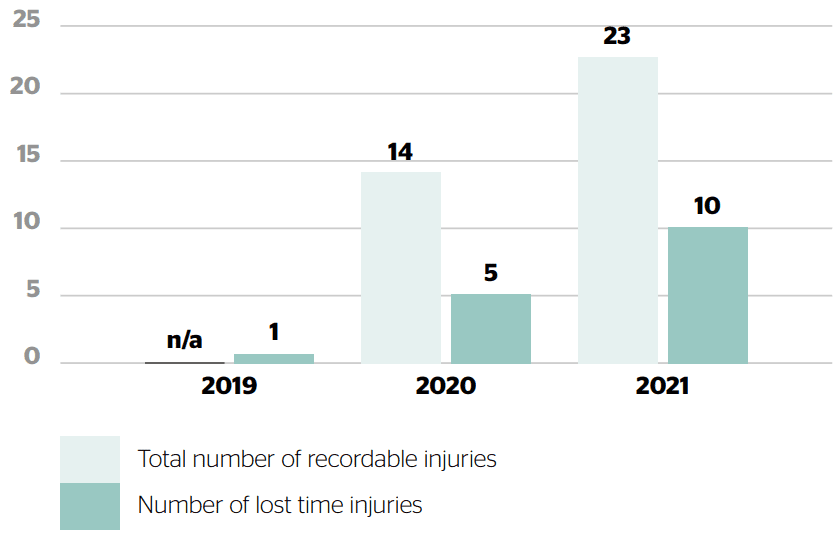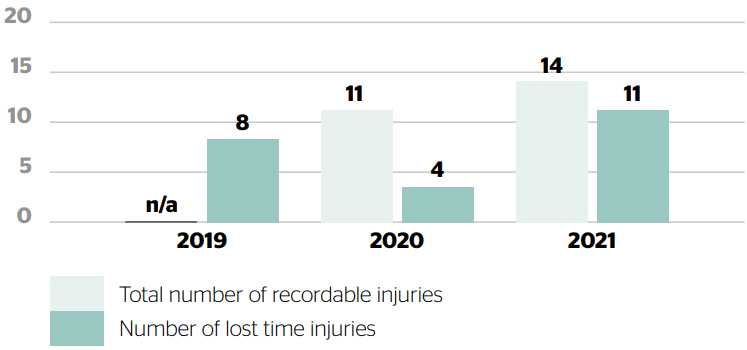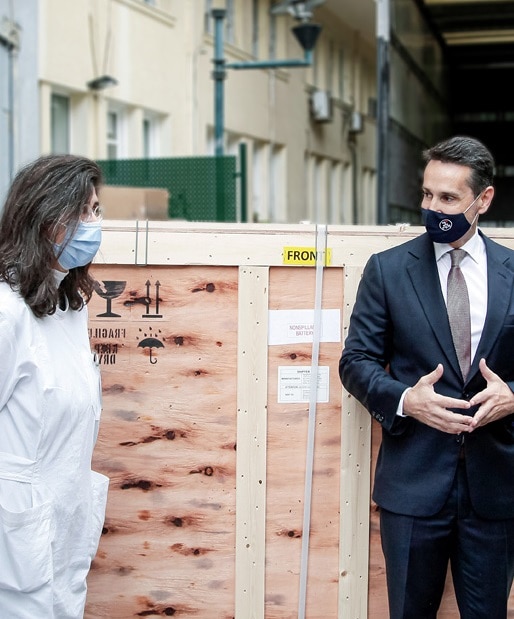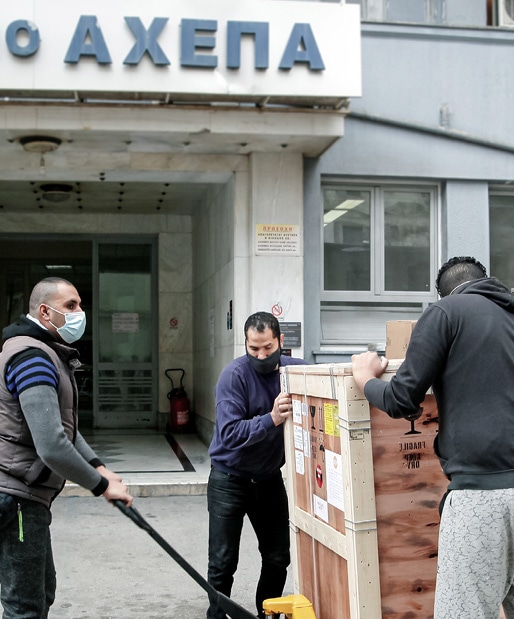Occupational Health & Safety


Materiality assessment process results
Scale: [0–10], where 0 "Not significant" and 10 "Very significant"
| Boundaries of the Material Topic |
|---|
| Where the impacts occur: To the employees and their families but also to third parties who work or visit the work areas of the Company’s Business Units, subsidiaries and permanent contractors and suppliers |
| By whom are the impacts caused: The impacts are caused by the Company’s Business Units and its subsidiaries, as well as by the independent contractors and key suppliers who cooperate with the Company. |
| The management of the topic by MYTILINEOS contributes to Sustainable Development:
|
| Topic of increased significance to: |
in the context of their cooperation with MYTILINEOS. |
Management Approach
[GRI 102-11] [GRI 103-2c]
The purpose of this disclosure is to help MYTIINEOS’ Stakeholders establish the best possible understanding of how the Company is managing this particular material topic, whose contribution to its responsible and sustainable development is crucial.
Occupational Health and Safety has always been fundamental to the operation of MYTILINEOS and a primary business goal. Asa responsible organization, MYTILINEOS acknowledges its responsibility to ensure the best possible Health & Safety conditions in all its work areas, as well as the right of its employees and of the employees of the independent contractors executing operations in its premises, to work without exposing themselves to any risk of injury or occupational disease.
Key Challenges / Impacts
[GRI 103-1a] [GRI 102-15]
- The elimination of accidents and occupational disease incidents at the workplace and especially at MYTILINEOS’ production facilities, promotes continuous, sustainable, productive employment and decent work, while it also places a decisive role in bolstering the Company's competitiveness.
- The positive contribution of MYTILINEOS to the well-being of the local communities in which it operates, by protecting the health and safety of its direct and indirect employees.
Major risks
[GRI 102-15]
- Direct or Indirect Accident Risks: Indirect risks create the conditions which lead to accidents and include the physical layout, functionality, access/evacuation routes, lighting and temperature of work areas. Direct risks lead to accidents or occupational diseases and include natural, chemical and biologicalfactors.
- Non-Accident Risks concern organizational, psychological and ergonomic factors that may not lead to an accident but affect the physical and mental health of employees in the short or the long run.
Commitment
[GRI 103-2c]
MYTILINEOS continues to work relentlessly, in all its Business Units, to achieve the goal of “ZERO ACCIDENTS AND ZERO OCCUPATIONAL DISEASES AT WORK”, which is one of the main challenges in the industrial sector, in accordance with the main priority areas of MYTILINEOS’ Occupational Health and Safety Policy.
Goal
[GRI 103-2c-iii]
The Company's targets, on an annual basis, are to achieve zero fatalities, zero accidents with serious consequences for the lives of employees, and zero occupational diseases, as well as to maintain the total recorded accidents rate at the lowest possiblelevel.
Risk Management / Control Practices
[GRI 103-2a]
- In all its Business Units, the Company, in addition to complying with the minimum statutory requirements, also implements an integrated and certified Occupational Health & Safety Management System voluntarily, designed to minimize risk, by allowing the continuous adoption of measures to prevent accidents and occupational diseases, providing for ongoing employee training and strengthening a safe work culture. The system is based on and certified in accordance with the ISO 45001:2018 international standard and, at the end of 2021, covered almost 90% of the Company’s production and RES plants in operation. The Health & Safety system covers all direct and indirect employees in the Company’s Business Units and in its subsidiaries that have in place an ISO 45001 certified Occupational Health & Safety Management System. In addition, 99% of employees are covered by a Health & Safety system that is subject to external audit, while 84% of employees are covered by a Health & Safety System that is audited or certified by an independent external body.
[GRI 403-1] [GRI 403-8] - MYTILINEOS adheres strictly to the applicable Greek and European laws in force and the regulatory provisions on Occupational Health & Safety. In many cases, the compliance of the operation of the Company's Business Units with the relevant legislation is achieved by the Company imposing itself much stricter limits through the relevant Management programs and systems in place.
- The systematic and continuous efforts to foster and promote a corporate Health and Safety culture, encourages all personnel to act responsibly for their own personal safety as well as for the safety of those around them and is a long-standing commitment in daily operations.
- Occupational Health and Safety is a line of responsibility that begins from the Management and the General Divisions and extends across all stages of production of all MYTILINEOS Business Units. To address the relevant risks, the Company has established and is strictly implementing security systems and safety measurements to assess their impact on the employees and to identify any need for interventions in all its work areas (offices and industrial facilities). At the same time, continuous progress and self-improvement depends greatly on both the preventive actions undertaken and the broader experience that the Company gains from every individual incident and near miss accident it analyses, while educating and training its personnel is crucial in order to maintain and further develop an accident prevention mentality.
- Hazards are identified using safety tools, whose purpose is to prevent hazardous actions and situations that could lead to accidents or occupational diseases and are described in a series of internal procedures in every Business Unit, both for direct employees and for indirect employees and business partners. Relevant examples include Management Safety Visits, Risk Identification and Inspections of Health and Environmental Safety Plans (HESP) for indirect employees, Occupational Risk Assessment (ORA), which is prepared in accordance with the respective procedure and is in place for every job position, risk management for the energy center, and work instructions for RES plants. Reporting of risks and hazardous situations takes place through the hazardous situations reporting process and the risk identification process, as well as through the reporting system of the Company's Code of Business Conduct. Regarding the procedure used to investigate work-related accidents, the Company has established and follows procedures for recording accidents in the accident log, for reporting and analyzing incidents, and for characterizing and investigating events, while at a higher level, selected incidents are analyzed using the “Root Cause Analysis” method. Through this procedure, appropriate corrective actions are determined so as to identify the required improvements to the OHS management system. At the same time, conducting internal inspections and external audits ensures the quality of procedures and the continuous improvement of the Occupational Health & Safety system. Employees may remove themselves from working conditions which they believe might cause injury or illness and are protected against potential retaliation, in accordance with the relevant provisions of the Code of Business Conduct. The Health & Safety Officers may recommend the removal of employees, where appropriate. Finally, Health and Safety issues are integrated into the central Enterprise Risk Management system (ERM), in order to further ensure their prioritization, as well as the required allocation of relevant resources for their improvement.
[GRI 403-2] [GRI 403-7] - MYTILINEOS implements occupational health practices that help identify and minimize Health & Safety risks. These practices include, among others, the operation of a clinic with the continuous presence of nurses and the regular presence of physicians, regular visits and inspections of the work areas by a specialist Occupational Physician, and medical services provided on a daily basis at the office clinic at no cost to all employees. In 2021, due to the SARS-CoV-2 pandemic, additional occupational health practices were implemented, the most important of which were conducting free COVID-19 tests for all personnel on the basis of an established schedule or in the case of emergencies, enabling remote work as a precaution for vulnerable and other employee groups, regular distribution of a special personal COVID protection kit to all employees, as well as special trainings and updates regarding the prevention measures adopted by the Company and regular disinfections of all premises.
[GRI 403-3] - To safeguard the health of its employees, in addition to access to public health structures, the Company provides them with an additional private health and medical care program. It also provides them with general medical services on a daily basis, at the clinic operating in its facilities, and implements a targeted vaccination programme for specific categories of personnel. Voluntary blood donation programs are also organized in the Company’s facilities at regular intervals. In 2021, actions focused on strengthening the mental health of employees and their families were introduced. In the framework of the Employee Assistance Program, the Psychological Support Hotline was created. This service provides 24-hour counselling support to employees and their families, delivered by a network of experienced psychologists and specialists in personal, family and employment-related matters, as well as free personalized in-person or remote (online) sessions. At the same time, on the occasion of the Mental Health Awareness Month, a series of experiential lectures was organized for information and discussion on a number of issues related to emotional and mental health, as well as, more generally, to the adoption of daily habits that promote health and well-being.
[GRI 403-6] - Health and hygiene issues are key to the quality of life of the employees and of the communities in which the Company operates. MYTILINEOS has been consistently investing in this area, monitoring, assessing and controlling all work environment parameters in an effort to constantly improve the good health of employees and ensure healthy living conditions at the workplace. Exposure to dust, noise, high temperatures and substances such as fluorine compounds, sulphur dioxide, carbon monoxide and aromatic polycyclic hydrocarbons, are the main parameters monitored systematically.
- MYTILINEOS develops and implements processes and actions that further improve the level of Health and Safety, by building on the findings of planned or unannounced safety inspections carried out by specially trained Company personnel, customers, business partners, public bodies and independentorganizations.
- In addition, every three months the CEO and the Executive Committee are informed of and assess the Company’s progress and performance regarding Health & Safety and provide appropriate guidance.
In terms of the organization of the Occupational Health and Safety function, relevant Departments operate at each MYTILINEOS Business Unit. Moreover, the Company ensures that the employees exercise their right to communicate comments, proposals and views on the procedures, policies and management practices for safeguarding and developing a positive culture promoting the safety and health of MYTILINEOS’ human capital. In line with this approach, special Health & Safety Committees operate in key activities in the Metallurgy and Sustainable Engineering Solutions (SES) Business Units. These Committees cover all employees, and both direct and indirect employees are represented and take active part in the procedures to determine how health and safety are managed at the workplace.
In the Metallurgy Business Unit, an official Plant Health & Safety Committee (PHSC) is established, representing 100% of the employees. The Committee consists of 6 members who are elected by the Business Unit’s employees. The PHSC has extended responsibilities and its members participate in all key procedures, committees or working groups. Most of all, however, it is the employees themselves, from all levels in the management hierarchy, who take active part in the continuous, systematic and methodical process that involves them in the formulation of safety rules and regulations. Moreover, the following additional Safety Committees have also been established, led by Management Executives and composed of representatives from all Plant departments: Work at Heights Committee, Lockout/Tagout & Confined Spaces Committee, Circulation Committee, Contracting and Training Committee. The issues discussed by the Committees cover those related to the Plant’s main processes, while proposals for the improvement or revision of these processes are also discussed. At the Volos Plant a three-member Health & Safety Committee is in place, set up in accordance with the provisions of the Greek law and consisting of employees, trade union representatives and members of the Management.
In the Sustainable Engineering Solutions (SES) Business Unit, the Health & Safety Committees operate at facility level (in every work site or plant) and represent 100% of the Company’s direct employees and over 90% of the employees of independent contractors. Additionally, the Safety Technician and the Occupational Physician work closely and are in constant communication with the Committee regarding issues related to hygiene, safety and the protection of employees. The Committee members, the Safety Technician, the Occupational Physician and the Company's representatives, participate in training programs on Health & Safety and in relevant official information days.
In the Renewables & Storage Development (RSD) Business Unit, the Health and Safety Officers, Safety Technicians and Safety Coordinators hold consultations with the employees, in the framework of the Occupational Health & Safety Management System. Moreover, in every work site facility, specialized personnel are constantly present for handling Health & Safety issues, First Aid services (personnel & equipment) are in place, while an ambulance and an Occupational Physician are present to offer first aid and deal with emergencies.
In the Power & Gas Business Unit, no official Occupational Health & Safety (OHS) Committee has been set up. A consultation process on these issues is however applied, with the active participation of personnel from the Company’s Energy Centers, in the context of the Occupational Health & Safety Management System. Relevant consultations take place at least once per year, in order to promote the implementation of the applicable Company OHS policy, to communicate information on OHS actions and programs and to involve the employees, through their active participation in the consultation process, in the management of occupational risk. Moreover, in the context of the OHS audits carried out in accordance with the established OHS Management System, a mechanism has been established to monitor the enforcement of the OHS regulations in the facilities and activities of the Company's Energy Centers, Head Offices, retail stores and RES plants.
Results
[GRI 103-3a-ii] [SASB EM-CM-320a.1] [SASB EM-MM-320a.1] [SASB IF-EU-320a.1] [SASB IF-EN-320a.1]
- The Business Units and subsidiaries of MYTILINEOS, in addition to the regular internal audits that they carry out, are subject to frequent external inspections by customers, government bodies and independent auditors, conducted to evaluate and improve the established Occupational Health & Safety Management Systems. In 2021, 57 internal audits and 76 external inspections were carried out.
- A total of 85 (2020: 88) incidents involving both direct and indirect employees –which, if not investigated, could pose a potential risk for employees (near misses) – were reported and investigated in production processes, representing a reduction by3%.
Direct employees
- The targets for zero work-related fatalities and zero serious incidents from occupational diseases were achieved.
[GRI 403-10] - The total number of recorded accidents stood at 23 and the corresponding frequency rate per 200,000 work hours was 0.85 accidents.
- Ten lost time accidents were recorded, resulting in a rate of 0.37 accidents per 200,000 work hours. More specifically, one serious accident occurred, involving the amputation of an employee’s upper limb, while the other less serious accidents involved cases of fractures, sprains, dislocations and burns. All incidents were analyzed using the "Root Cause Analysis” method, in order to establish their causes and communicate the results of their investigation, so as to ensure that they will not happenagain.
- The total number of visits to the medical stations stood at 15, increased by 40% compared to 2020.
- No employees were involved in activities with a risk of exposure to work-related diseases.
[GRI 403-10]

For yet another year, particular attention was also paid to the prevention of serious accidents through training. A total of 6,608 man-hours of training in Health and Safety were implemented in all Business Units, attended by 61% of direct employees. The training, which covers both general and specialized Health & Safety topics, focused on the following topics:
- Identification of Risks
- Fire protection, fire safety
- Work at heights, in confined areas, in underground work sites
- Hazard Assessment
- Safe movement of pedestrians, machinery & vehicles
- Musculoskeletal risks
- Emergency Plans
- Safe performance of electrical work
- Lockout/Tagout of Facilities
- Health & Safety in the offices
- Emergency First Aid at Work
- “Safety at Work” introductory training
- Cleanliness of premises
- Information updates about COVID-19
- Mental health at the workplace (COVID-19)
In addition, in 2021 the Company organized experiential lectures on psychosocial risks, employee resilience, health and well-being. The program of the lectures, which consisted of 11 modules, was attended by 151 employees who participated in trainings in the following topics:
- Introduction to the Well-being program
- "Correct body posture”
- “Giving up smoking”
- “The ability to concentrate under stressful conditions”
- “Psychological First Aid”
- “Management of psychosocial risks”
- “Management of Emergencies”
- “Professional Burnout”
- “Depression”
- “Behavior analysis as a method to defuse phobias and panic attacks”
- “Nutrition & its 4 Keys (Thinking, Emotion, Physical response, Behavior)”
| Health & Safety Indicators | 2019 | 2020 | 2021 |
|---|---|---|---|
| Fatality Rate (FR) / 200,000 work hours | |||
| FR (Total) | 0.00 | 0.00 | 0.00 |
| FR (Men) | 0.00 | 0.00 | 0.00 |
| FR (Women) | 0.00 | 0.00 | 0.00 |
| High Consequence Injury Rate (HCIR) / 200,00 work hours | |||
| HCIR (Total) | n/a | 0.00 | 0.07 |
| HCIR (Men) | n/a | 0.00 | 0.09 |
| HCIR (Women) | n/a | 0.00 | 0.00 |
| Total Recordable Injury Rate (TRIR) / 200,000 work hours | |||
| TRIR (Total) | n/a | 0.53 | 0.85 |
| TRIR (Men) | n/a | 0.60 | 1.01 |
| TRIR (Women) | n/a | 0.21 | 0.20 |
| Lost Time Injury Rate (LTIR) / 200,000 work hours | |||
| LTIR (Total) | 0.04 | 0.19 | 0.37 |
| LTIR (Men) | 0.05 | 0.18 | 0.41 |
| LTIR (Women) | 0.00 | 0.22 | 0.20 |
| |||
Indirect employees
Managing the safety of the personnel of independent contractors is a particular challenge for MYTILINEOS. The Company is consistent in its efforts in this area and focuses on the need to alter everyone's behavior and mentality about accident prevention. For example, contractors who employ a significant number of personnel at the facilities of the Metallurgy Business Unit's aluminium plant, are required to have in place an ISO 45001 certified Occupational Health & Safety Management System, while the Company evaluates regularly their performance using specific criteria. Similarly, the management of Health and Safety issues in the Sustainable Engineering Solutions (SES) Business Unit is governed by a series of actions that must be implemented by associated contractors, so as to ensure that the Occupational Health & Safety Management System, which is drawn up separately for each project, is correctly implemented, and that they take the appropriate measures in the context of the specific work that they undertake.

- Despite the efforts made, we regret to report one fatality due to fall from a height, involving an employee of a contractor in the Sustainable Engineering Solutions (SES) BusinessUnit.
- The total number of accidents recorded stood at 14 and the accident frequency rate per 200,000 work hours was 0.29 accidents.
- Eleven lost time accidents were recorded, resulting in a frequency rate of 0.22 accidents per 200,000 hours worked.
- A total of 41 visits of employees to the medical (first aid) stations were recorded, increased compared to 2020.
- With a view to strengthening and consolidating a common safety culture among all MYTILINEOS’ business partners, 28,000 man-hours of training were implemented, in topics similar to those for direct employees.
[GRI 103-2c-vii] [GRI 403-5]
| Health & Safety Indicators | 2019 | 2020 | 2021 |
|---|---|---|---|
| Fatality Rate (FR) / 200,000 work hours | |||
| FR (Total) | 0.00 | 0.03 | 0.02 |
| FR (Men) | 0.00 | 0.04 | 0.02 |
| FR (Women) | 0.00 | 0.00 | 0.00 |
| High Consequence Injury Rate (HCIR) / 200,00 work hours | |||
| HCIR (Total) | n/a | 0.03 | 0.00 |
| HCIR (Men) | n/a | 0.04 | 0.00 |
| HCIR (Women) | n/a | 0.00 | 0.00 |
| Total Recordable Injury Rate (TRIR) / 200,000 work hours | |||
| TRIR (Total) | n/a | 0.38 | 0.29 |
| TRIR (Men) | n/a | 0.38 | 0.30 |
| TRIR (Women) | n/a | 0.41 | 0.00 |
| Lost Time Injury Rate (LTIR) / 200,000 work hours | |||
| LTIR (Total) | 0.19 | 0.14 | 0.22 |
| LTIR (Men) | 0.19 | 0.11 | 0.24 |
| LTIR (Women) | 0.00 | 0.41 | 0.00 |
| |||
MYTILINEOS’ response to the SARS-CoV-2 pandemic
From the first moment the pandemic broke out, MYTILINEOS responded swiftly and effectively, implementing a multifaceted action plan that ensured the protection and safety of its employees, maintaining all its production units in operation and contributing to the national effort to address the pandemic crisis. The primary objectives of MYTILINEOS in 2021, for which the Company allocated over €4 million, were the following:
1. To safeguard the health of its employees and their safety at work, as well as the health of their families.
Since 2020, MYTILINEOS took a number of steps that included the following:
- Establishment of a special Covid Management Team tasked with monitoring the pandemic and with assessing and managing related risks, in order to protect its employees.
- Development of a comprehensive preventive action plan two weeks before the first confirmed case occurred in the country, which is constantly updated according to developments.
- Constant provision to its employees and business partners of information updates on the application of the personal hygiene regulations, accompanied with clear instructions obtained from the competent international and domestic bodies.
- Enabling teleworking already from the first month of the pandemic.
- Creation of a special “SARS-CoV-2 – What I need to know” microsite, and establishment of an “HR Call Centre” for keeping employees up-to-date.
- Regular distribution of a special personal kit per employee, containing face masks and antiseptics.
- Implementation of regular disinfections in all facilities.
- Carrying out molecular (PCR) and rapid diagnostic tests with a total cost of almost €1.8 million (for 2021) for its employees in Athens, Volos and the Aluminium of Greece plant.
2. To ensure its uninterrupted operation.
One of MYTILINEOS’ primary objectives was to maintain its smooth operation. In this context, relevant activities included the following:
- Maintaining Business Continuity plans, with targeted measures that were adapted to support the Company’s production units that may remained in full operation.
- Maintaining the operation of a communication and management network consisting of special teams in all the Company's facilities in Greece and abroad.
- Constantly reviewing the need for business trips and visits to production units.
- Implementing special precautionary measures for sales agents and customers at the Protergia retail stores.
- Continuing the implementation of the Company's investment program.
In conclusion, the holistic approach that MYTILINEOS applied and continues to apply for mitigating the impacts of the pandemic and ensuring its business continuity, maintains the guarantees required by its investors. With ambitious business decisions, the Company is taking advantage of the opportunities emerging from the public health crisis and accelerates its progress towards an even stronger green economy.

